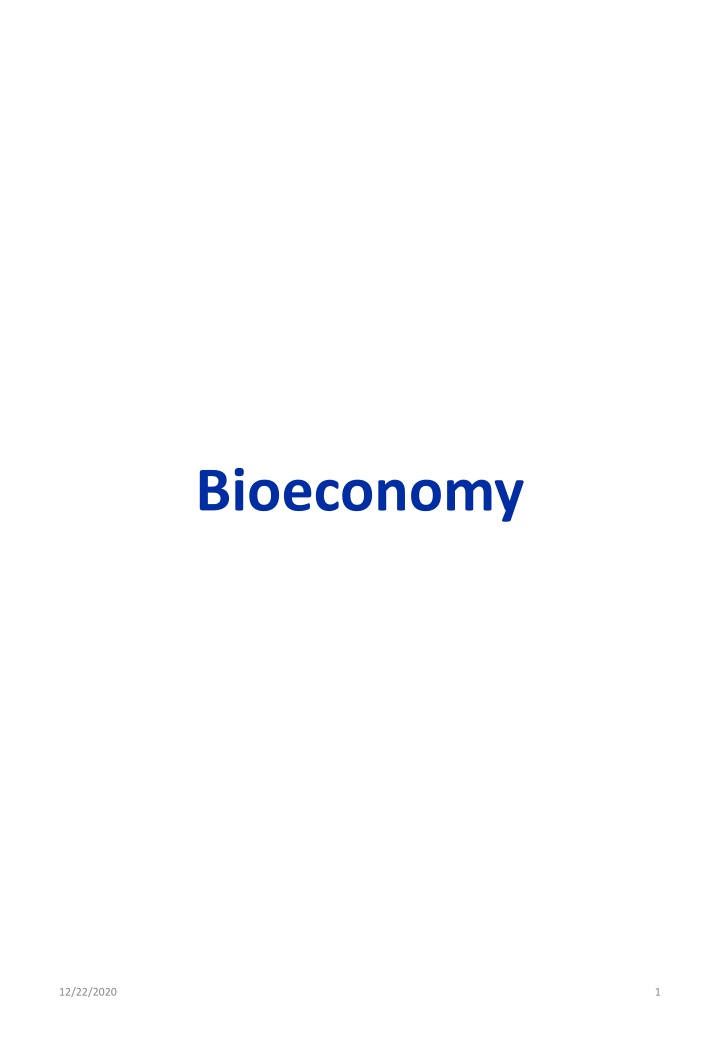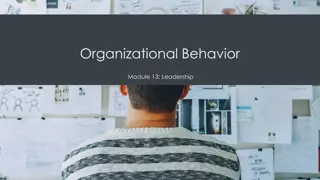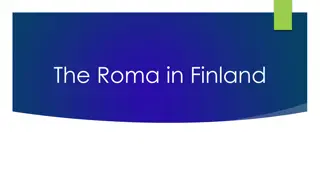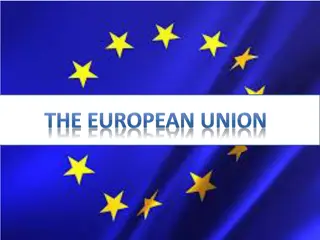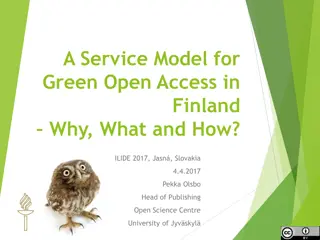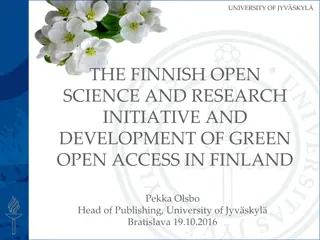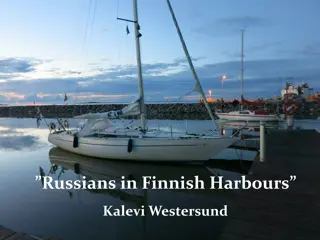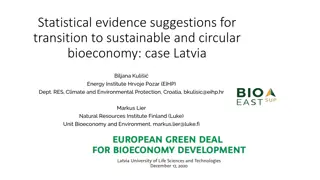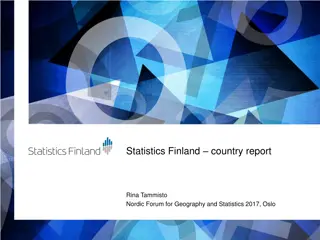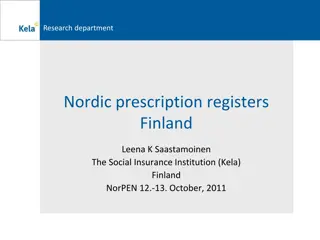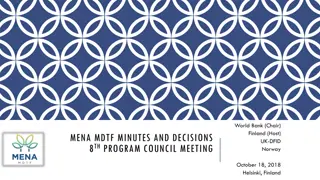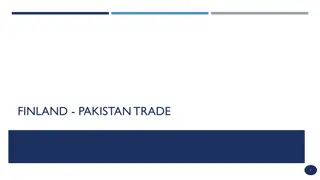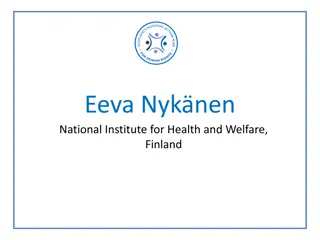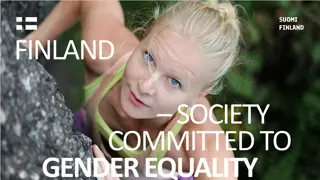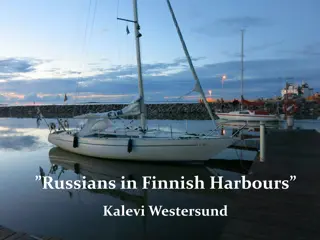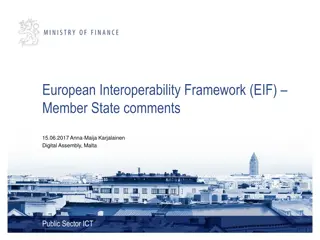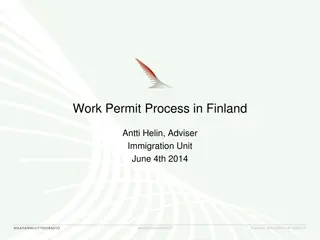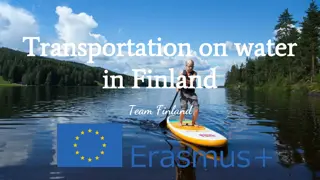Finland's Leadership in Sustainable Bioeconomy Solutions
Finland's bioeconomy approach aims to combat climate change, biodiversity loss, and promote economic growth with renewable resources. Leveraging its forestry expertise, Finland excels in developing wood-based products, leading the way in sustainable solutions that can be applied globally. Through responsible forest management and innovative research, Finland showcases a model for fostering a bioeconomy that aligns with sustainable development goals.
Download Presentation

Please find below an Image/Link to download the presentation.
The content on the website is provided AS IS for your information and personal use only. It may not be sold, licensed, or shared on other websites without obtaining consent from the author.If you encounter any issues during the download, it is possible that the publisher has removed the file from their server.
You are allowed to download the files provided on this website for personal or commercial use, subject to the condition that they are used lawfully. All files are the property of their respective owners.
The content on the website is provided AS IS for your information and personal use only. It may not be sold, licensed, or shared on other websites without obtaining consent from the author.
E N D
Presentation Transcript
Bioeconomy 12/22/2020 1
PART I: GENERAL INFORMATION 12/22/2020 2
Key points and main messages Finland believes the bioeconomy can help mitigate climate change, and, if used responsibly, help fight the biodiversity crisis. It can also encourage sustainable economic growth, particularly for less developed rural areas. Finland has been developing a sustainable bioeconomy for centuries, focusing on responsible forestry. A commitment to education and research has made Finland one of the best places in the world to develop bioeconomy solutions. Other Finnish strengths, such as in software and mobile communications, are also critically important to the bioeconomy. Long experience and cutting-edge research has made Finland a global leader in new wood-based products which can replace oil and textiles. Everything that is made out of plastics can be made out of wood, and we do it already. Finland s forestry companies have invested heavily into wood-based packaging and there have been several promising developments to create textiles from a variety of raw materials, including wood. Much of the technology that has been developed to transform wood-based cellulose can also be used with other biological resources, such as straw and crop residue from agriculture. This means solutions developed to be used on Nordic forests can even be used in countries which don t have a forest industry. How to portray Finland? Position Finland a forerunner in the bioeconomy sector. HighlightFinland s long history and special strengths using wood as a versatile material. Profile Finland as a place international partners come to develop bioeconomy solutions. 12/22/2020 3
Elevator pitch: bioeconomy Bioeconomy is an economy that relies on renewable resources to produce food, energy, products and services. A responsible bioeconomy will reduce our dependence on fossil-based natural resources, help prevent biodiversity loss and create new economic growth which is consistent with sustainable development. Finland has developed its bioeconomy for hundreds of years, in particular its forestry industry. Finland manages its forests responsibly and sustainably. In fact, there is 50% more timber in Finland s forests than 50 years ago, according to Forest Finland. After a tree is felled, the standard procedure is to plant four new trees in its place. Long commercial experience and research in the entire forestry value chain has discovered how wood can replace many wasteful materials, such as oil and textiles. Much of the technology that has been developed to transform wood-based cellulose can also be used with other biological resources, such as straw and crop residue from agriculture. This means solutions developed to be used on Nordic forests can even be used in countries which don t have a forest industry. Other Finnish strengths are useful to the bioeconomy, such as in software, mobile communications and design. The Finnish state has given strong, stable, long-term policy support to ensure the stable growth and development of the bioeconomy. Finland s 2025 vision is that sustainable solutions will form the basis of the country s future welfare state and competitiveness. Finnish companies, universities and other organizations are actively seeking international partners to help develop radical bioeconomy innovations. 12/22/2020 4
Background 1/2 The climate and biodiversity crisis forces us to find new, sustainable ways of living. A key is to replace fossil fuels and materials with sustainable materials. Transitioning to a bioeconomy is a critical piece of the sustainability solution. The bioeconomy can shorten supply chains and boost local economies. Fossil fuels might need to be shipped halfway around the world, but many plants and trees used in the bioeconomy can be produced and processed locally. Rural communities, which are often underdeveloped compared to urban areas, gain more jobs. It is difficult for a country to develop a bioeconomy in isolation. It is faster and easier to nurture profitable international partnerships. Finland is superbly placed to advance the bioeconomy thanks to its historic strengths in forestry. About 78% of Finland is covered by forest. The forest industry generates about 20 billion euros in turnover and makes up 27% of Finland s net exports. Wood, as a versatile raw material, has received the most interest in Finland. Oil can be replaced with wood in many products. Everything that can be made out of plastics can be made out of wood, and we are doing it today. Wood can be used in bioplastics, biochemicals, biofuels, textiles, pharmaceuticals, food additives and rubber. Finnish companies have even made wooden sinks and wooden casts for broken bones. In many cases these wood-based products have superior characteristics than the old fossil-based products. Much of the technology that has been developed to transform wood-based cellulose can also be used with other biological resources, such as straw and crop residue from agriculture. This means solutions developed to be used on Nordic forests can even be used in countries which don t have a forest industry. 12/22/2020 5
Background 2/2 Finland is also a forerunner when it comes to using wood in construction. Public support and innovative private companies have used wood in surprising and intriguing places, such as urban locales and in infrastructure like bridges. Packaging is one of the most exciting sectors in the bioeconomy, thanks to the global awareness of plastic pollution. Finland s forestry companies have invested heavily into wood-based packaging, including bioplastics. The sector has also received government support, such as through Business Finland. Textiles is another industry where Finland has shown global competitive strengths. The traditional clothing and fashion industry is detrimental to the environment. There have been several promising developments to create textiles from a variety of raw materials, including wood. Business Finland believes Finnish innovations could replace 1/3 of global cotton production. Many Finnish organizations have experience working with international partners. For example, Mets partnered with the Japanese company Itochu to form an industrial scale pilot plant to produce textile fibres from wood. 12/22/2020 6
Facts and stats The bioeconomy added 26 billion euros to the Finnish economy in 2019. All stats are from Statistics Finland and the Natural Resources Institute Finland (Luke), unless stated otherwise. The bioeconomy makes up 13% of the Finnish economy. Over 300,000 persons are employed in the Finnish bioeconomy. Forestry is the largest bioeconomy sector (9 billion euros), followed by construction (4.6) and food (4.3). Bioeconomy services is one of the fastest growing sectors. Output grew 5.2% in 2019 while investments leaped 9.3% and the number employed climbed 2.8%. Food attracted the most investments, 1.7 billion euros, in 2019. Forestry received 1.4 billion euros in investments while the energy sector received 949 million euros. Over the long term the energy sector is seeing investments grow the fastest, at about 13% annually. Mets s bioproduct mill in nekoski is the largest wood-processing plant in the Northern Hemisphere. The company says it has a capacity of 1.3 million tonnes of pulp annually and creates more than twice the amount of electricity it needs. In addition to traditional pulp products, the mill creates bioproducts like tall oil and biogas. Finland s national target is to have 30% of biofuels in road transport by 2030. This is more ambitious than the EU s targets of 14% for renewable fuels and 3.5% for advanced biofuels. Finland is an expert at sustainable and responsible bioeconomy solutions. There is over 50% more timber than 50 years ago in Finland s forests. For every tree felled four new trees are planted, according to Forest Finland. 12/22/2020 7
Some Finnish companies in the field Finsect farms insects and makes insect-based foods for human consumption Gold and Green Foods makes pulled oats, a plant protein Honkajoki processes animal by-products into raw materials for animal food, fertilizers, cosmetics and fuels Huhtamaki specialist in sustainable food and drink packaging Infinited Fiber uses waste paper and other materials to make a cotton-like fibre using technology developed at VTT Technical Research Centre Ioncell creates textiles from old biomaterials in a process developed at Aalto University Kotka Mills supplies wood, paper for laminates and recyclable board products, such as for convenience foods Mets Group a large forestry group which focuses on tissue papers, paperboard, pulp, timber and forestry services Neste develops renewable diesel from materials such as used cooking oil and animal fat waste from the food industry Paptic startup which developed a sustainable material as an alternative to plastic Pure Waste uses cotton cutting waste and recycled polyester fibres to create new textiles Raisio supplies fish farms with fishmeal made from local ingredients St1 creates ethanol from biowaste and residues Stora Enso a multinational forestry company which focuses on wood in the bioeconomy Sulapac uses sustainable materials to replace single-use plastics and other plastics UPM a major global forestry corporation which develops wood-based products Verso Food developed a meat substitute from fava beans Woodly nine-year-old startup which created a new type of plastic based on wood. 12/22/2020 8
Programs and main markets Bio and circular Finland The four-year program is aimed at innovation, internationalization services and renewable ecosystems. It helps Finnish companies to expand into international markets and find international partners. It also attracts foreign talent, companies and investors to Finland. The main themes are packages, waste-to-value, textiles, circular solutions, building sector and bio-based solutions. Wood building programme The program aims to promote the use of wood in construction. Note the current program ends in 2021, but other resources might be available from the Ministry. 12/22/2020 9
Sites to visit in Finland European Forest Institute based in Joensuu, Finland, the EFI is an international organization which researches and promotes the bioeconomy Mets Fibre s nekoski bioproduct mill the mill is the largest and most advanced in Finland and produces traditional wood pulp as well as new bioproducts Oodi Helsinki s new flagship library demonstrates how wood can be used in modern, urban architecture University of Helsinki Forest Bioeconomy, Business and Sustainability Researchers at the Viikki campus seek international collaborations and partnerships with academics and companies. EU delegation visit sites At the bottom of this page is a list of bioeconomy excursions that an EU delegation made in 2019. They include research and commercial sites throughout Finland. Experts who can give good lectures on the topic Please let VIE-50 know if you have suggestions of good speakers. We will update this material. 12/22/2020 10
For social media @BioeconomyFI @Business Finland @Cleantech Finland @Ministry of Agriculture and Forestry @VTT Finland @SitraFund #bioeconomy #teamfinland #sustainability #forest #bioplastic #cleantech Everything that can be made out of plastic can be made out of wood. And in #Finland we already do. #bioplastic The bioeconomy makes up 13% of #Finland s economy. #Finland has 50% more timber than 50 years ago. The #bioeconomy can be sustainable. Investments in energy in the #bioeconomy are growing 13% annually in #Finland. For further information Petri Heino, Wood building programme, Ministry of the Environment, petri.heino@ym.fi, +358 295250203 Kirsi Joensuu, Executive Director, Finnish Forest Association, kirsi.Joensuu@smy.fi, +358 40 8400642 Marika Ollaranta, Head of Program, Bio and circular Finland, Business Finland, marika.ollaranta@businessfinland.fi , +358 504 804 611 Jarmo Heinonen, Senior Director, Innovation Ecosystems, Industries, Business Finland, jarmo.e.heinonen@businessfinland.fi, +358 50 5577 790. 12/22/2020 11
Tools and materials Bioeconomy and circular economy The Ministry of Agriculture and Forestry of Finland has a good, comprehensive array of resources. This includes news; a list of strategies, programs and projects; and information on particular sectors: forests, food, freshwater and bioenergy. Finnish bioeconomy in numbers The Natural Resources Institute Finland (Luke) and Statistics Finland keep an updated list of bioeconomy statistics. Other information can be found in Luke s E-yearbook of Food and Natural Resource Statistics and their page for Finnish forest statistics. Bioeconomy.fi This public-interest and promotion website is maintained by the Finnish Ministries of Agriculture and Forestry, Economic Affairs and Employment, and Environment. It also has a material bank in several languages. Bioeconomy The Finnish Innovation Fund Sitra has provided publications and ideas about the bioeconomy for almost ten years. It remains one important piece of their carbon- neutral circular economy theme. 12/22/2020 12
PART II: COUNTRY SPECIFIC INFORMATION 12/22/2020 13
Key points and main messages What are the most important things to emphasize in this specific country? What is Finland s special knowhow that makes us stand out especially in this country? Why should someone from this country want to cooperate, invest or buy? 12/22/2020 14
Elevator pitch Write a clear, brief message/commercial about the sector and Finland's knowhow. Position Finland: who are we and why people should trust us in this country State the problem that needs to be solved in this country and globally Present our solution and results with focus on the needs of this country: explain what we do, how we do it and what makes us unique. Eliminate jargon but wrap everything into a good story Finish with a call to action: what do we want to happen next, where do we want to go? 12/22/2020 15
Background, facts and stats This is the part where you add facts to support and explain your elevator pitch. Short history and development of the sector in your country. List all essential facts and numbers that a person needs to understand the size and significance of the sector in your country. Why and how did this become a key sector for Finland? What is the broader role of Finland in this sector, what is our position in comparison to other countries? 12/22/2020 16
Finnish companies in the area Please list Finnish companies operating in this sector in your country. Write shortly (1-2 sentences) what they have to offer. Team Finland Name of persons in charge of this sector in your country: name, title, organization, email, phone number. 12/22/2020 17
PART III: INSTRUCTIONS AND BACKGROUND FOR THIS INTERNAL MATERIAL PACKAGE 12/22/2020 18
Material package: instructions This is an internal working paper to support all Team Finland actors globally in promoting Finland and its strengths. The Unit for Public Diplomacy of the Ministry for Foreign Affairs coordinates the production of sectoral working papers in close cooperation with Business Finland and other core actors. The sectoral working papers can be found in the internal Team Finland section of the Finland Toolbox. Parts I-II Part I of consists of general information that can be used globally when preparing for meetings, visits, events, campaigns, etc. Part II is left blank. All Team Finland teams around the world are encouraged to fill in country specific information and use it actively! Hyperlinks When you read the content in normal view, the hyperlinks are not clickable. You can either open the hyperlinks by right-clicking on them and selecting Open Hyperlink or by switching to slide show view and clicking on them . Questions and comments If you have questions or suggestions concerning the format or content, please contact The Unit for Public Diplomacy at vie-50@formin.fi. 12/22/2020 19
Country branding and Team Finland work: why do we need common messages? Country branding is advocacy, communications and marketing that aims to influence target groups knowledge, opinions and eventually decisions through owned and earned media, events and meetings, among other means. Country branding is carried out by everybody who speaks about, writes about or documents Finland. Country image work is part of the normal work of our all Finnish actors abroad when they have meetings, are present in the media, give speeches, etc. It is not just about individual functions or events. It is extremely important that all relevant actors prioritize themes together and deliver the same main messages highlighting Finland's strengths. Sufficient cultural sensitivity is needed, always adapt Finland s strengths to each cultural area and current discussion. Finland s country image work is led by the Finland Promotion Board (FPB). In 2019 2023, the member organizations are: Ministry for Foreign Affairs, Ministry of Economic Affairs and Employment, Ministry of Education and Culture, Finnish National Agency for Education, Business Finland, Visit Finland, City of Helsinki, House of Lapland, Finnish Cultural and Academic Institutes, the Finnish Innovation Fund Sitra, Music Finland, W rtsil , Finnair and Iceye. 12/22/2020 20
